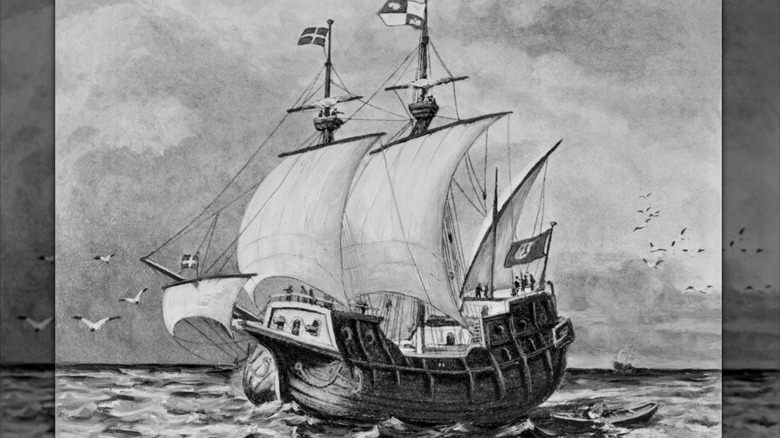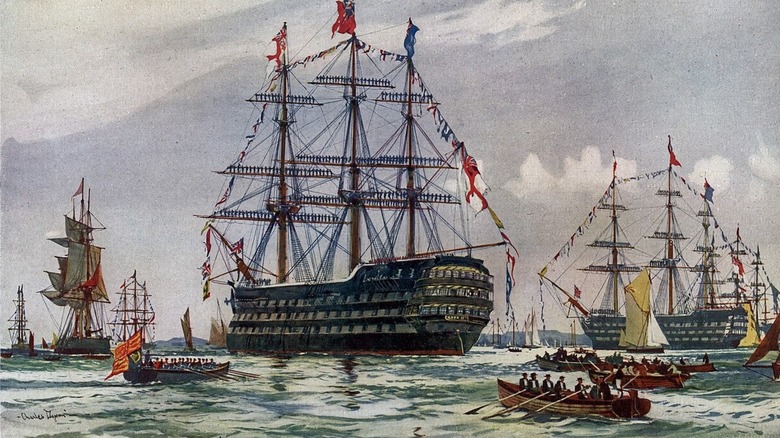What's The Difference Between A Galleon And A Ship Of The Line?
Between the mid-16th century and mid-19th century, tall ships — a term used to define traditionally rigged sailing vessels — ruled the high seas. During this Age of the Sail, different types of ships (with cool names) emerged, some of which are still in use today. For instance, modern navies still use frigates and corvettes, while schooners and sloops are still sailed by civilians. Others, like the galleon, brig, and brigantine (which are different), barque and barquentine (also different), man-of-war, and ship of the line, have mostly sailed into history.
All sailing ships are identifiable by how many masts they have, how they're arranged, and how many fore, aft, or square sails they use — also known as their rigging. For instance, the USS Constitution (aka "Old Ironsides"), a three-masted frigate launched in October 1797 – has 42,710 sq. ft. of sail and still sits in Charlestown, Massachusetts. The tall ship that crashed into the Brooklyn Bridge in May 2025 was a Mexican naval vessel (also with three masts) called the ARM Cuauhtémoc. It was built in 1982 to replicate an old barque-style ship with over 25,500 square feet of sail. Both the Constitution and Cuauhtémoc have three masts, but because they sport different rigging, they are considered different types of sailing vessels.
So, what's the difference between a galleon and a ship of the line? The answer is pretty straightforward — the ship of the line was a purpose-built ship made for war that evolved from what was the benign merchant galleon due to changes in naval strategy during the 16th century.
Galleons were put into service as warships
European sailing vessels began to evolve in the 16th century, and one of the byproducts was the galleon. This ship took the best features from its predecessors — the caravel (a style of ship that changed exploration forever) and the carrack. They weren't primarily made as galleys (aka war vessels), as several countries used them as merchant ships during times of peace and were sturdy enough to hold up to open ocean voyages. However, they were cheaper to build than caravels or carracks and could easily be converted into warships.
The galleon had a longer hull than the caravel, which gave it better stability. The forward part of this ship's upper deck — called a forecastle – was also lower than that of a caravel's, and it was lower than the aft castle, giving it less wind resistance, thus making it faster and more maneuverable. When outfitted for war, it tended to have more ribs and bracing throughout the hull to withstand the added cannon firepower. A "beak" used to ram ships was placed below the bowsprit.
A galleon's design varied significantly by region and was often built explicitly for its homeport, regular destinations, and cargo it typically carried. Still, it usually sported three masts (but could have four), with square-rigged fore (front) and main (center) masts and a lateen-rigged mizzenmast at the rear. Square-rigged masts have large square canvas sails set on yards hanging horizontally from the mast at right angles to the keel, while lateen-rigged masts have triangular sails hanging from long yards on one side of the mast.
Ships of the line were built specifically for war
The ship of the line evolved from the galleon. Still, unlike the galleon, which was initially just a merchant ship converted to a warship, this particular ship was built specifically for war and carried exponentially more armament into battle. In fact, from the mid-17th century through the mid-19th century, it was the premiere warship around which nearly all navies in the Western world formed their fleet.
Somewhere around the mid-17th century, naval warfare morphed into ships attacking each other in a single column. Each vessel would follow roughly 100 yards behind the next and fire its entire complement of cannons broadside simultaneously. Each ship had to have enough wooden plank armor to withstand the constant barrage and enough firepower to dish out ship-sinking damage. Ships strong enough to do both could enter this line of battle, and became known as ships of the line.
The top-tier, first-rate ships of the line had more than one hundred cannons placed along three decks with a crew of some 850 men. Second-rate ships (also with three decks) carried between 90 and 98 guns, but third-rate ships (usually the most common in a fleet) only had two decks and carried between 64 and 80 cannons. Lesser-rated ships carried fewer and fewer cannons, and included vessel types like frigates, sloops, brigs, or cutters often used as convoy escorts, troop carriers, or scout vessels. As a frame or reference, the entire U.S. naval force in 1815 consisted of just 18 warships including the ship of the line Independence (a ship that changed navy warfare forever), five frigates, two sloops-of-war, seven brigs, and three schooners.


